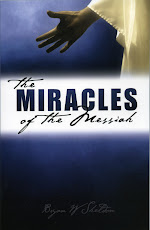The Significance of the Death of the Messiah
Going back to the principles laid down in Genesis, spilt blood implies:
(1) A substitutionary sacrifice, (like the lambs of Abel’s flock , or the ram replacing Isaac on the altar).
(2) A life taken unjustly, (like Abel, the first martyr).
(3) A life taken justly, (in payment for a crime).
It could be argued that the blood of the Messiah was shed in compliance with these three principles.
(1) As a substitutionary sacrifice.
(2) Was a life taken unjustly.
(3) Was payment for a capital crime.
That the death of the Messiah falls into the category of (2) ‘a life taken unjustly’ is self-evident. The judicial killing of Jesus of Nazareth was the murder of the only innocent man that ever lived. He was holy, harmless, undefiled and separate from sinners. Pilate, the only judge that mattered, said, “I find no fault in this man” (Luke 23.4; John 19.6).
It was also the payment for (3) capital crime, though not His own. This points to the idea of (1) substitution (one life given instead of another). It is evident that the New Testament emphasis is on this substitutionary aspect of the death of the Messiah. Peter wrote, “… who Himself bore our sins in His own body on the tree” (1 Pet.2:24). Again, “For Christ also suffered once for sins, the just for the unjust, that He might bring us to God” (1 Pet.3:18) Paul wrote, “For He made Him who knew no sin to be sin for us, that we might become the righteousness of God in Him” (2 Cor.5:21). These echo the prophecy of Isaiah, “He was wounded for our transgressions, He was bruised for our iniquities” (Isa.53:5). “All we like sheep have gone astray; We have turned, every one, to his own way; And the LORD has laid on Him the iniquity of us all” (Isa.53:6).
With Moses, the sacrifice of the Passover lambs, evidenced by the blood applied to the doorways of the homes of the Israelite slaves, was the best illustration of this spiritual principle. Meditation on this momentous event was also the best educator of the nation and Moses commanded them, and future generations, to remember and celebrate it annually.
Notwithstanding the spiritual principle established at the exodus, the substitutionary nature of the death of the Messiah was not just one life for another but one life instead of all others. This truth is at the heart of the great Adam passage in Romans 5, where Paul wrote that as one man’s act of disobedience brought judgement and death to all men, so the act of obedience by One Man brought justification, and removed the death sentence. “Therefore, as through one man’s offence judgment came to all men, resulting in condemnation, even so through one Man’s righteous act the free gift came to all men, resulting in justification of life. For as by one man’s disobedience many were made sinners, so also by one Man’s obedience many will be made righteous” (Rom.5:18,19) In his other great Adam passage, he says it even more clearly. “For as in Adam all die, even so in Christ all shall be made alive” (1 Cor.15:22).
The theological implications of the death of Christ in this manner, is normally expressed by such words as ‘propitiation’, ‘expiation’ and ‘purification’,
Historically, there are three stages in the provision of ‘propitiation’.
(i) Because God is holy, His wrath is directed toward sin and must be appeased to spare man from eternal destruction. His wrath was awakened by Adam’s transgression.
(ii) God provided the remedy by sending Christ as a sin offering.
(iii) Christ’s death assuaged the wrath of God, satisfied His holiness and averted His wrath.
Propitiation is Godward; God is propitiated—His holiness is vindicated and satisfied by the death of Christ. The Greek verb ἱλάσκομαι (propitiation) occurs twice in the New Testament, in Luke 18.13 and significantly in Hebrews, “Therefore, in all things He had to be made like His brethren, that He might be a merciful and faithful High Priest in things pertaining to God, to make propitiation for the sins of the people” (Heb.2:17) As a noun it appears in John’s letters, “And He Himself is the propitiation for our sins, and not for ours only but also for the whole world,” (1 John 2:2) and “In this is love, not that we loved God, but that He loved us and sent His Son to be the propitiation for our sins” (1 John 4:10). It appears once again in Paul’s writing. “Whom God set forth as a propitiation by His blood, through faith, to demonstrate His righteousness, because in His forbearance God had passed over the sins that were previously committed” (Rom.3:25).
Expiation is not a word that is found in the New Testament but some translations use it to replace ‘propitiation’. While the primary meaning of ἱλασμός means ‘propitiation’, it surely contains something of the sense of expiation. While propitiation is Godward, expiation is manward or rather sinward. It is sin that needs to be expiated. The death of Christ not only propitiated God but also expiated sin, allowing God to “demonstrate at the present time His righteousness, that He might be just and the justifier of the one who has faith in Jesus” (Rom.3:26) The death of Jesus Christ is presented as the ground on which a righteous God can pardon a guilty and sinful race without in any way compromising His righteousness.









